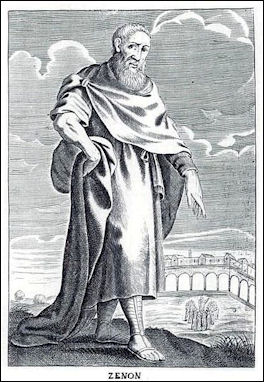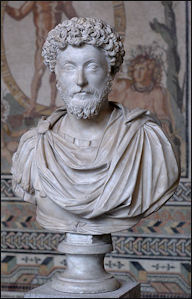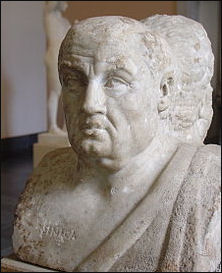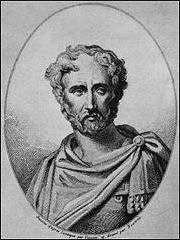ANCIENT ROMAN PHILOSOPHERS

Zeno of Citium in Thomas
Stanley History of PhilosophyRoman philosophy was mostly borrowed from the Greeks. Cicero (106-43 B.C.) is credited with introducing Greek philosophy to Rome. Prominent philosophers included Lucreius (96?-55 B.C.), an Epicurian; the Stoics’ Epictetus (A.D. 60? -130?) and Marcus Aurelius (121-180).
Zeno of Citium (335-263 B.C.) and the Stoics exalted reason, identified it with reason, and counseled an ascetic disregard for misfortune. Zeno "preached that wise men should remain indifferent to the vanities of the transient world." The Stoics gave us the word stoic, meaning: enduring pain or hardship without showing feelings or complaining.
The late 1st century B.C. and the first century A.D. was the Golden Age of Roman literature, rhetoric and philosophy. Great Roman famous poets included the naughty Catuluus, the romantics Tibullus and Propertius, the epic-maker Virgil and the love scribe Ovid. The great historians and rhetoricians include Horace, Livy, Cicero and Caesar from the later Republican period and Petronius and Seneca from the early Imperial period.
Lucius Annaeus Seneca (4 B.C." 65 AD) served as Nero's tutor dominated Nero's court until he was forced to commit suicide at Nero's command. He wrote about the pursuit of the well-being of the soul and made many observations of about Roman history, every day life and politics that have made their way to us today.
Cicero, see Politics
Marcus Aurelius

Marcus_AureliusMarcus Aurelius (born 121, ruled 161-180) was the adopted son of Antonius Pius. He is regarded as a reflective philosopher-emperor and the last of the good emperors. He took the throne at a time when Rome's shortcomings and vulnerability were becoming apparent. The rich were hopelessly decadent, the middle class was disappearing, labor was performed mostly by slaves, and threats were present in the north and the east.
Marcus Aurelius followed the stoic philosophy. He dressed plainly and lived frugally and wrote a book on philosophy called Meditations that is still quoted today. In regard to his position, Marcus Aurelius wrote: "As the Emperor, Rome is my homeland; but as a man, I am a citizen of the world...Asia and Europe are mere dots on the map, the ocean is a drop of water, Mount Athos is a grain of sand in the universe."
Marcus Aurelius believed that the good of society had precedence over individual comforts. While he was fending off invaders, he passed many reforms, suppressed gladiator spectacles, passed laws protecting slaves. Although his philosophy dovetailed with many Christian doctrines he persecuted Christian because they were regarded as a threat to the empire. His image endures on a famous equestrian statue in Rome.
Meditations is a treatise on the Stoic philosophy extolling the importance of virtue. In modern China, after Premier Wen Jiabao claimed he had read Marcus Aurelius's Meditations nearly 100 times the work became a top seller in China, reaching No. 5 on the bestseller list.
Ancient Roman Historians

SenecaThe Romans were great historians who seemed to record and write down almost everything they saw. Much of what we know about the Greece, Greek art, early Christianity and life the Holy Land when Jesus was alive is based on Roman accounts. The Romans left behind so much information in fact we know more about more about Europe 2,000 years ago than were know about North America 300 or 400 years ago.
Influential writers, observers and historians included Horace, Pliny, Seneca, Juvenal, Cato, Martial the historians Tacitus (A.D. 56-120) and L. Casius Dio, the biographer Suetonius and the prose Romantic Petronius d. (66 AD).
Cambridge classics professor Mary Beard told an interviewer that Tacitus's The Annals is the best work of history ever written. “Take the murder of Nero's mother," she said. “There is no better story than Nero's attempts to murder his mother with whom he is finally very pissed off! Nero the mad boy emperor decides that he is going to get rid of mum by a rather clever collapsible boat. He has her to dinner, waves her fondly farewell. The boat collapses. Sadly for Nero, his mum, Agrippina, is a very strong swimmer and she makes it to the land and back home. And she's clever, she knows boats don't just collapse like that---it was a completely calm night, so she works out Nero was out to get her. She knows things are going to end badly. Nero can't let her off, so he sends round the tough guys to murder her. Agrippina looks them in the eye and says, “Strike me in the belly with your sword." There are two things going on. One is: my son who came out of my belly is trying to murder me. But the other thing we know is that they were widely reputed to have had an incestuous relationship in the earlier days. So it's not just Nero the son murdering his mother, but Nero the lover murdering his discarded mistress. And if you read Robert Graves's I, Claudius, some of it comes directly from this.
When asked if it's better than a Hollywood plot, Beard said, “Yes but it's not just that. What he does is seduce you with an extraordinary tale. But, there is also a cynical, hard-hitting analysis of corruption. Reading Tacitus in Latin is like reading James Joyce. It's language which is really at the margins of comprehensibility as well as being very exciting. But, actually, he wants to talk about the corruption of autocracy. It's about one-man rule going bad."
Much of what we know about the Holy Land around the time of Jesus is based on accounts by Flavius Josephus (A.D. 37-100), the pro-Roman Jewish governor of Galilee, in his books The Jewish War and Jewish Antiquities . Josephus was born to an upper-class Jewish family. He became the governor of Galilee at the age of 31 in A.D. 68 and later led a Jewish liberation army against Rome. When he was Rome, he was spared when he told the Roman general Vespasian that he was a Jewish messiah and a future emperor of Rome. When Vespasian did in fact become emperor, Josephesus was give a generous pension and comfortable apartment. He spent the rest of his life writing books that attempted to explain whey the Jews revolted.
Pliny the Elder

Pliny the ElderPliny the Elder was one of the world's greater chroniclers. An avowed workaholic, he wrote his historical works and encyclopedia with "20,000 noteworthy facts" in his free time while he worked as an army officer, bureaucrat, governor in several provinces and admiral in Rome's largest fleet. Pliny was born in northern Italy in A.D. 23. Little is known about his early life. Pliny the Younger was his nephew. [Source: Jerry Dennis, Smithsonian, November 1995]
"What made Pliny's achievement possible," wrote classicist Lionel Casson, "was a fanatical way he had of making every minute count. He burned the midnight oil literally: his standard routine was to get in hours of study before the break of day, when his official responsibilities began."
Pliny often began his day at midnight and worked 20 or 24 hours a day. He kept a pen and writing tablet next his plate so he could jot notes while eating. When he traveled about the streets of Rome he insisted on being carried by slaves in litter, instead of wasting his time walking, so he could continue reading and work on route. His personal secretary was outfit with a special long sleeve tunic that enabled him to take notes even in bad climate weather and he often worked while getting a massage at the Roman baths.
Pliny was obsessed with the written word and is also credited with introducing the a table of contents. He poured over countless Greek and Latin texts, even ordering his secretary to read to him even while he was dining or taking a bath. He believed books were the ultimate repository of knowledge, “our civilization---or at any rate our written records---depends especially on the use of writing materials," he wrote.
Works by Pliny the Elder
Pliny once wrote: "Nature, that is to say, life is my subject." Natural History , Pliny's 37-book encyclopedia, referenced 2,000 volumes by at least 1000 authors. It contained facts about astronomy, geology, meteorology, geography, anthropology, botany, medicine, zoology, art, helmets with ostrich plumes, types of mattresses and the difficulties of sponge diving. He offered tips of raising bees and figs, described how ro make glue from oxhides, gave advice on choosing onions and reported heaps of fantastic and erroneous information.
In Natural History , Pliny described a race of headless people whose eyes were on their shoulders, two-headed people who communicated by barking, fast-running people with 16 toes and backward feet; one-legged people that got around by hoping; big-footed people who reclined on their backs and used their feet as umbrellas; and mouthless people who drew their nourishment from roots.
Animals in Natural History included elks lacking knee joints, lions with human faces, scorpions with tails that fed on people, and snakes that preyed on elephants and were capable bursting rocks with their breath. Natural History was a bestsellers and assumed as fact through the Middle Ages. Pliny also wrote The Art of Using a Javelin on Horseback , Life of Pomponius Secundus , The History of Wars in Germany , The Students , Linguistic Queries and History of Our Own Times .
Pliny the Elder and the Eruption of Vesuvius
While most people headed as quickly as they could away from Pompeii, the very curious Roman historian and naturalist Pliny the Elder headed straight for it. At the time of the eruption Pliny and his nephew, Pliny the Younger, were across the Bay of Naples, 15 miles from Vesuvius and 20 miles away from Pompeii. The elder Pliny considered the eruption a novelty and, taking a Roman fleet with him, sailed towards Pompeii. The nephew initially stayed behind and wrote an account of what happened, apparently pieced together from his own observations and the accounts of survivors.
Pliny the Younger wrote that Pliny the Elder "had been out in the sun, and taken a cold bath" and "my mother drew his attention to a cloud of unusual size and appearance...It was not clear from which mountain the cloud was rising. Later we knew it was Vesuvius...My uncle's scholarly acumen saw at once it was important enough for a closer inspection and he ordered a boat to be made ready."
"He was entirely fearless...he hurried to the place everyone else was hastily leaving...Ashes were already falling, hotter and thicker as the ships drew near." His boat was bombarded with fiery ashfall and blocked with floating rafts of pumice but eventually he made it to Stabiae which was about the same distance from Pompeii as Pompeii was from Vesuvius.
To calm his friends Pliny told them "the broad sheets of fire and leaping flames" were "nothing but the bonfires left by peasants." Later, while his companions debated whether to stay in their house or flee, Pliny slept soundly through the first night of the eruption. When the houses starting shaking violently, they put pillows on their heads to protect themselves from falling rocks."
Pliny the Elder died in the eruption of Vesuvius. He advised calm when the volcano began erupting and stayed in Pompeii even though he had enough warning to escape. He went outside the day after the initial eruption, on August 25, with a pillow tied to his head. Some think that Pliny the Elder died choked by ash after landing in the beach near Pompeii.
Pliny the Younger wrote that August 25, was "blacker and denser than any ordinary night." Violent waves made escape by sea impossible. Pliny grew tired and repeatedly asked for cold water. Then suddenly the "flames and smell of sulphur" drove his companions to flight. The elder Pliny collapsed, perhaps from a heart attack or from breathing in toxic fumes, and two days later his body was found on a beach at Stabiae "entire an uninjured...its postured that of sleeping, rather than a dead man."
Image Sources: Wikimedia Commons, The Louvre, The British Museum
Text Sources: New York Times, Washington Post, Los Angeles Times, Times of London, Yomiuri Shimbun, The Guardian, National Geographic, The New Yorker, Time, Newsweek, Reuters, AP, Lonely Planet Guides, Compton's Encyclopedia and various books and other publications. Most of the information about Greco-Roman science, geography, medicine, time, sculpture and drama was taken from "The Discoverers" [∞] and "The Creators" [μ]" by Daniel Boorstin. Most of the information about Greek everyday life was taken from a book entitled "Greek and Roman Life" by Ian Jenkins from the British Museum [||].
No comments:
Post a Comment